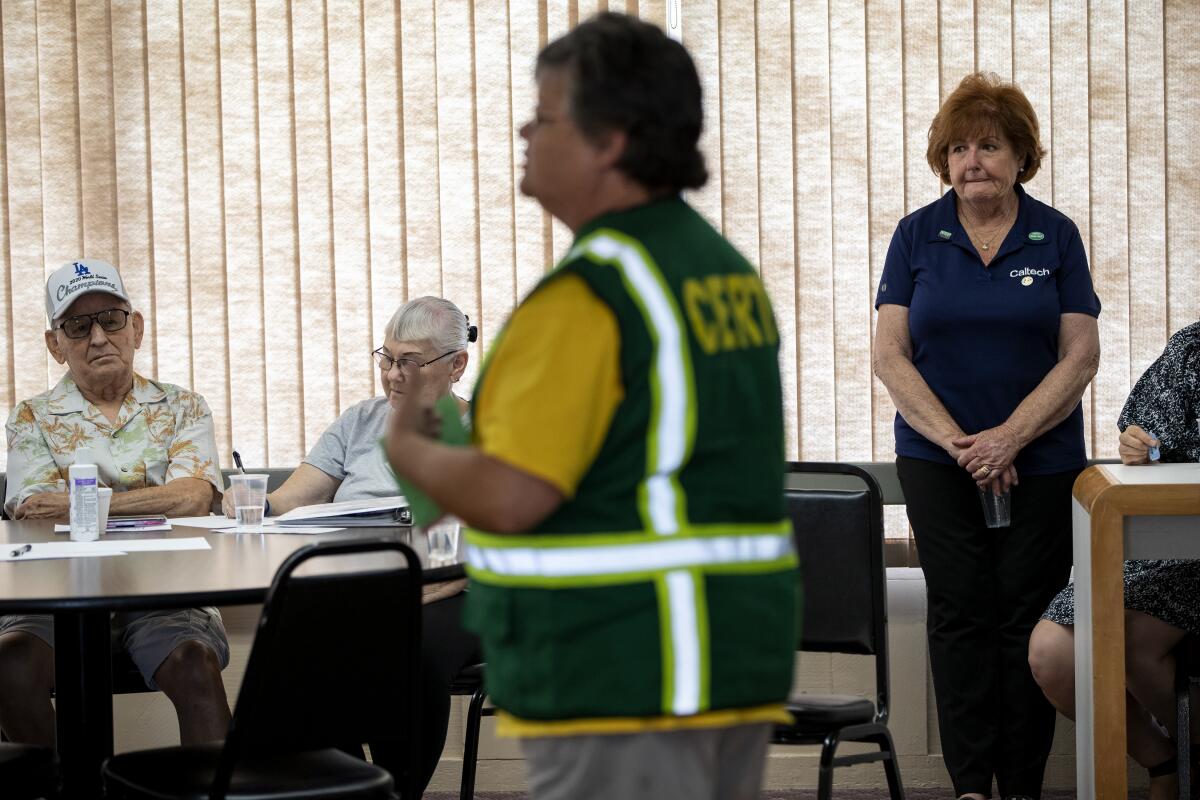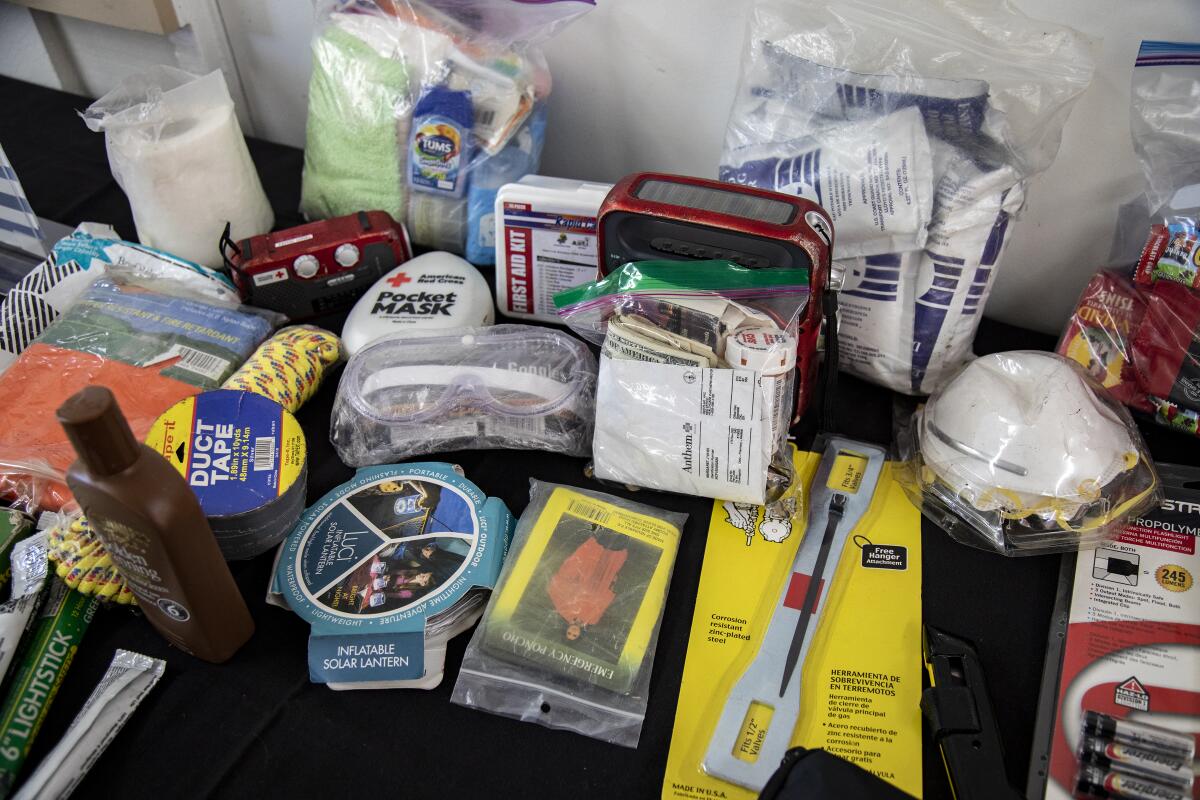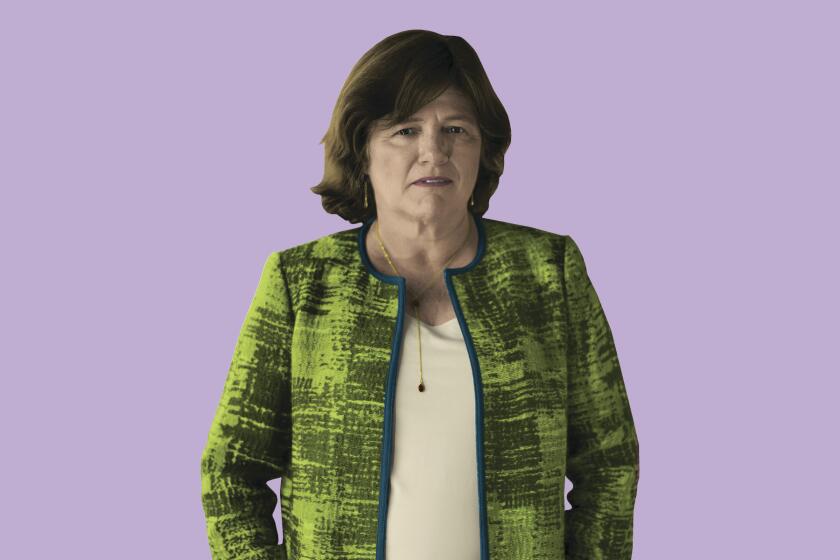After an earthquake, neighbors will need to help neighbors. Here’s how to get your community ready

- Share via
Imagine that the Big One has just hit. You had already participated in the Los Angeles Times’ Unshaken newsletter series, so you were better prepared for a major earthquake than most, but you’ve still been affected. Sirens of emergency response vehicles are miles away, but you and your neighbors need help now.
What can you do?
If you’re anything like the residents of the Knolls of Murrieta, a group of three 55-plus communities in Riverside County, you know exactly what to do. That’s because the neighborhoods participate in the Community Emergency Response Team, or CERT, and Map Your Neighborhood programs.
Here’s what you need to know about getting your neighborhood set up for success.
What is CERT?
“Survivability in any disaster is neighbor helping neighbor,” Margaret Vinci, administrator at the Caltech Seismological Laboratory, said at a disaster preparedness event for Spring Knolls this month.
CERT is a nationwide training program, but it got its start in Los Angeles County in 1985. The Whittier Narrows earthquake in 1987 made the program’s value clear. It empowers neighbors to help fellow neighbors by providing education on basic disaster response skills, including first aid, search and rescue, and fire safety.
In the aftermath of a disaster, first responders are usually focused on large issues such as fires or mudslides. So when it comes to helping yourself or others, a strong community can mean the difference between life and death.
Bonnie Casler, a certified CERT trainer for Spring Knolls, lives by the “five Ps” she learned in the Army: Prior planning prevents poor performance. Preparedness, for any disaster, is key to coming out OK on the other side.
“Do what you can do,” she said, and for the rest, rely on your community.
There are four types of CERT programs available (standard, teen, campus and workplace), and active groups in all 50 states. All apply the same principles of self-reliance to a specific community, and getting started is the same in all scenarios.
CERT training consists of nine educational units — each one covering a different aspect of emergency preparedness — over about 40 hours.
The first unit starts with an overview of general emergency preparedness, knowledge and skills. The second focuses on what CERT is and what it means to be a member. Units three and four focus on first aid, and unit five is about the psychological effects of disasters. The remaining units cover topics including search and rescue, utilities, and terrorism.
Casler said her community adapted the program to include the unique needs of a 55-and-older community, including people with limited mobility.
Once you’ve completed the courses, you’ll take an exam and participate in a mock emergency. Then you’re an official member of your community’s emergency response team.
Trainings have to be overseen and conducted by a certified trainer like Casler. To become a certified trainer, you must seek approval from local first responder organizations.
Once you are a certified CERT volunteer, you’ll need to stay up to date on your training and keep your emergency supplies in tiptop shape. When disaster does strike, whatever it may be, you will be a leader in your community and coordinate efforts with first responders to assist in evacuations, damage control and saving lives.
The first line of defense isn’t going to be the fire department or the police; it’ll be you, then your neighbors. Joining or starting a CERT is just one more step you can take to make yourself more resilient in the face of disaster.

What is Map Your Neighborhood?
Getting to know your neighbors is a key component to your resilience after a disaster, seismologist Lucy Jones wrote recently.
One way to do that is through Map Your Neighborhood, sponsored by Earthquake Country Alliance. It was created to build community relationships.
Cindy Woody, who leads the area coordinators at Spring Knolls, said that you need to “get to know your people” so that when disaster strikes, the face offering help is a familiar one.
The process of mapping your neighborhood includes creating a running list of who lives in your community, what their needs are and what they have to offer to the collective. Does your neighbor two doors down have a generator handy? If so, ask if the community can count on them to provide backup power in case electricity goes out. What about your neighbor across the street who uses a wheelchair? Make sure someone can get to them and help them evacuate if need be.
The program also includes preparation and safety tips you can complete on your own and those you can complete with neighbors after a disaster.
A registry of community members, what their needs are and what supplies they have to offer is kept by area coordinators.
When combined with CERT, these two programs provide your community a road map to navigating the aftermath of a disaster.
People are much more important than kits. People will help each other when the power is out or they are thirsty. And people will help a community rebuild and keep Southern California a place we all want to live after a major quake.
How can you start in your neighborhood?
First check to see whether a CERT has already been established in your area. You can search by address, neighborhood or ZIP Code.
If there isn’t one in your area, or you want to start a separate one for your neighborhood, you can sign up to become a CERT trainer and start your own group.
Woody recommends for CERT and Map Your Neighborhood that you start by recruiting a small group of neighbors, then expanding to the rest of your community.
If you’re interested in the Map Your Neighborhood program, check if your city already sponsors groups. Pasadena, Signal Hill, Manhattan Beach, Los Angeles (under a different name) and other cities have established programs. If your area doesn’t have one, the Los Angeles-area Red Cross offers training to get you started.

What else can you do?
You don’t have to wait till doomsday to get to know your neighbors, Casler said. Building social capital is just as important for day-to-day needs as it is for emergency circumstances.
Things like heat waves and power outages can create problems for your community too, said Alan Hanson, coordinator for the Spring Knolls CERT. Knowing who may need help and how to help them under any circumstance is the point of these programs and something he said the community in Murrieta emphasizes.
But when it does come to disaster, everyone can pitch in “no matter your age or disability,” Woody said. The saying “it takes a village” is especially true when it comes to recovering after a major disaster.
Some people might not feel comfortable getting involved for one reason or another. Doug Strosnider, fire inspector for the Murrieta Fire Department, said it’s OK to call 911 for an emergency, or to call a non-emergency dispatch if you see something that needs to be addressed.
Woody said that the COVID-19 pandemic was the disaster that no one had anticipated, but that because of the training and connections made through CERT and Map Your Neighborhood in her community, they were able to activate and assist those in need. Rather than evacuating or doing first aid, area coordinators were bringing residents groceries and cat food, she said. The principle was the same: neighbors helping neighbors.
MyShake is the early-warning app recommended for Southern Californians. But there are others you can download. What are they and which ones might you want?
More to Read
Sign up for Essential California
The most important California stories and recommendations in your inbox every morning.
You may occasionally receive promotional content from the Los Angeles Times.
















